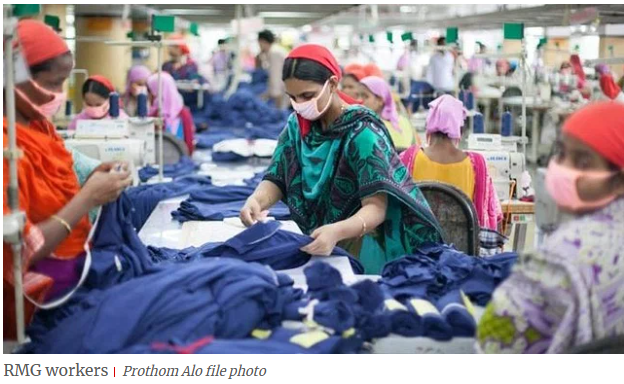In the first 11 months of the outgoing year, there has been a notable decline in Bangladesh’s garment exports to the United States, a major destination for ready-made garments. The United States constitutes 18 percent of Bangladesh’s total garment exports. The market has experienced uncertainty and fluctuations in recent months.
During the 11 months from January to November of the outgoing year, Bangladesh’s exports of ready-made garments to the United States amounted to USD 6.79 billion. This reflects a significant decrease of one-fourth (24.91 per cent) compared to the corresponding period of the previous year. In contrast, during the first 11 months of 2022, Bangladesh exported ready-made garments worth USD 904 million to the United States.
Nevertheless, not only Bangladesh but also the exports of the other five top apparel exporting countries to the United States have experienced a decline ranging from 21.5 to approximately 26 per cent. Essentially, US traders reduced imports of ready-made garments by about 22 per cent in the first 11 months of the previous year compared to the corresponding period a year earlier. This reduction has had a negative impact on the exports of all the major exporting countries.
Exporters from Bangladesh argue that inflation in the United States has been increasing since the onset of the Russia-Ukraine war in February 2022. In June of that year, the country’s inflation soared to 9.1 per cent, marking the highest in 40 years. Consequently, consumers in the country reduced purchases of products other than daily commodities and fuel. Inflation subsided as the country implemented various initiatives, including raising policy interest rates, and by November, it had dropped to 3.1 per cent. Therefore, exporters believe that the rate of receiving purchase orders from the country’s brands and buyers may increase by the end of this month.
According to the updated statistics from the Office of Textiles and Apparel (OTEXA) under the US Department of Commerce, US businesses imported USD 72.41 billion worth of clothing from January to November last year. In the same period of 2022, they imported clothes worth USD 93.31 billion. This indicates a 22.40 per cent decline in US apparel imports during the first 11 months of the outgoing year.
China remains the top apparel exporter to the US market. In the 11 months of the last year, China’s garment exports decreased by 25.85 per cent to USD 15.22 billion. Vietnam, the second top exporter, exported $13.18 billion worth of clothing, with their exports decreasing by 22.68 per cent. Bangladesh stands as the third top exporting country in this market, holding a market share of 9.47 per cent. China and Vietnam hold shares of 21 and 18 per cent, respectively.
According to OTEXA data, Bangladesh’s garment exports to the US market have increased by 2.33 per cent over a period of 10 years. Exports in 2012 were USD 4.18 billion. The next year saw an increase to USD 4.65 billion.
After the Rana Plaza collapse in Savar in April of that year, garment exports to the United States declined. The situation began changing with the start of the US trade war with China, prompting many American buyers to turn to Bangladesh with increased purchase orders to reduce their dependence on China and avoid high tariffs. In 2022, clothing exports to the US market increased to 9.72 billion dollars.
For the fiscal year 2022-23, garment exports amounted to USD 46.99 billion. Of this, 18.12 per cent or USD 8.52 billion worth of clothing was destined for the United States. However, exports subsequently fell by 5.5 per cent. In the first five months of the current financial year 2023-24 (July-November), clothing worth USD 18.83 billion was exported, with 17.40 per cent going to the United States.
However, during this period, exports to the market fell by 5.75 per cent. Bangladesh-US tension has been ongoing for several months over political issues. Last May, the United States announced a new visa policy to ensure free, fair, and peaceful national elections in Bangladesh. For that reason, when the country announced a new policy for the protection of labour rights worldwide on 16 November, especially entrepreneurs in the ready-made clothing industry in Bangladesh became worried.
However, Fazlul Haque, the former president of BKMEA, an organisation of knitwear industry owners, commented that there is no relationship between the political tension and the decrease in garment exports to the US market. Yesterday, he told Prothom Alo that the purchase orders from the country have fallen mainly due to the decrease in demand caused by high inflation and a huge stock of unsold goods in the warehouse.
Fazlul Haque also said, “After the long holiday of Christmas, the representatives of brands and buying institutions have started returning to work. They have initiated discussions about placing new purchase orders. Christmas sales were good. As a result, we expect the rate of purchase orders to increase towards the end of January. It will take another two weeks to confirm that.”
source: prothomalo.com
RMG exports US




